#Low Cost Carrier Airlines Market
Explore tagged Tumblr posts
Text
Low-Cost Carrier Airlines Market: Soaring into Affordability Explore the Skies with Low-Cost Carrier Airlines. Uncover Market Trends, Affordable Travel Options, and Future Projections. Your Guide to Budget-Friendly Flying. 🛫
0 notes
Text
No. 15 - PSA (Pacific Southwest Airlines)

Thank you to @lobstersinmyhouse for requesting PSA! And, in all honesty, this is exactly my feelings too. Pack it up, post over.
...okay, no. I am going to write a post, but I make no secret of loving PSA's airplanes. After all, one is even my icon.

image: Piergiuliano Chesi
There was never an airline like it before PSA sprang up in 1949, and there has never been an airline like it since. Decades after its demise I still feel a real sense of grief about the fact that it's gone. Pacific Southwest Airlines hasn't existed for longer than its entire time in operation and it mostly only operated in a single state, but it remains one of the most beloved airlines ever to exist. I'm certainly far from immune to catching their smile. So I'm very, very excited to cover the iconic grinningbirds, one of the best-known airline liveries of all time even 40 years after the regional carrier which wore it ceased existing.
youtube
PSA officially stands for Pacific Southwest Airlines. Unofficially, it was the Poor Sailor's Airline. According to a button they put out, it was this.

image: psa-history.org
But really, it can stand for anything you want. I think it stands for Pretty Smiling Airplanes.
You see, PSA's marketing leaned into the fun and casual as much as it was possible for an airline to do. They called themselves "The World's Friendliest Airline". Their branding was all bright, colorful, delightful. One aspect of it is particularly well known.
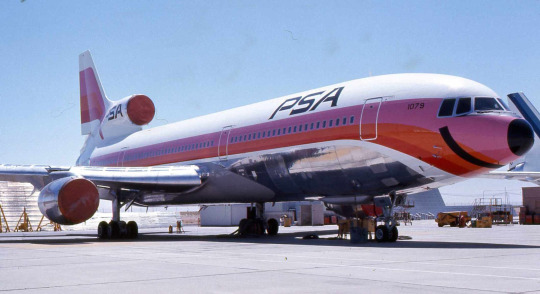
image: Piergiuliano Chesi
The name "grinningbird" is literal. PSA's fleet was lovingly painted with massive smiles directly under their noses. Their advertisements encouraged people to "catch our smile" across the state of California.

A preserved DC-3 in original Pacific Southwest livery
PSA was started as a single leased DC-3 hopping from San Diego to Oakland. Apparently their ticket office was literally a refitted military surplus latrine where they weighed passenger baggage on a bathroom scale. When they expanded with DC-4s they painted rectangles around the windows to make them look more like DC-6s. This was in 1955. And then, by the early 60s, they were taking off.
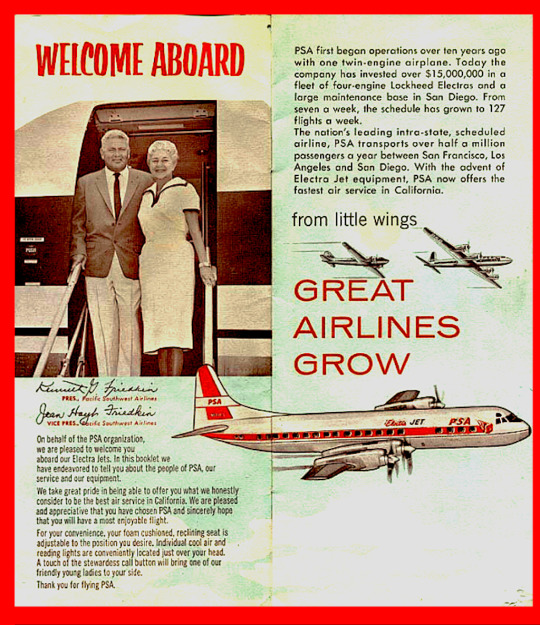

A pre-smile PSA Electra. The L-188 Electra is, of course, my favorite jet plane. image: Jon Proctor
It was in the 60s that their planes stopped saying 'Pacific Southwest Airlines' and started just being PSA, and it was in the 60s when they caught their smiles. This was the point when PSA became PSA, transforming from just another intrastate airline in the pre-deregulation era to a turning point in aviation history.
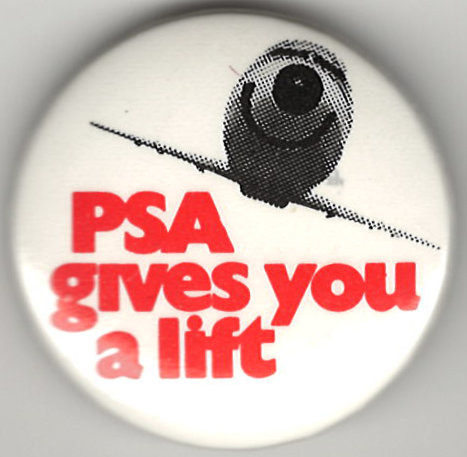
a 1972 promotional button image: psa-history.org
While the smiley faces are the most significant historical fact about PSA, also notable is the fact that they were the first low-cost carrier in history. Although PSA's routes were limited to Southern California, they charged $9.99 for a ticket other airlines would charge $13.50 or $22.05 for - and keep in mind that in today's money that's a difference of hundreds of dollars. Free of federal fare taxes and operating frequently, PSA grew at an intense pace with its new fleet of Lockheed L-188 Electras.

I love the L-188 Electra (not to be confused with the earlier L-10 Electra best known for Amelia Earhart reasons). Although Lockheed has long since moved over to exclusively making weapons for killing people, back when they were in the civil airliner market they made the most incredible planes which somehow ended up commercially flopping time after time. The Electra, for instance, was all but killed immediately by two early crashes caused by a sneaky design flaw. These were fixed, but the type's reputation had already been sullied. (Interestingly, similar early design flaws with far less prompt responses failed to kill either the DC-6 or the DC-10, despite the latter causing the deadliest crash in history at the time and the former having had the serious potential to give us a timeline where the President of the United States was killed because his presidential transport had a design flaw which encouraged going up in flames midair.) Ironically, the Electra is actually an insanely reliable and sturdy plane, and the example pictured is still in service as an air tanker under the registration C-GZCF, still doing her thing at just 63 years young. (Another Electra in Air Spray's fleet is a similar age but also survived being bisected across the belly by her own detached propeller, and she literally flew two days ago. These planes are on a level only shared with Nokia cell phones, especially for their size.)
That paragraph became about the Lockheed L-188 Electra. I did not mean for it to be, but I am leaving it in, because I love this plane. Looks great with the smile, too. The roundness of the nose gives the distinct appearance of something like a teddy bear snout.
From this point things only grew quicker. PSA continued to be PSA, acquiring more aircraft to fly more passengers. They did expand routes eventually, and once the 1978 Deregulation Act allowed they flew to some other states and even Mexico. Despite this, they remained an icon in their home state, and are often called "the unofficial flag carrier of California".
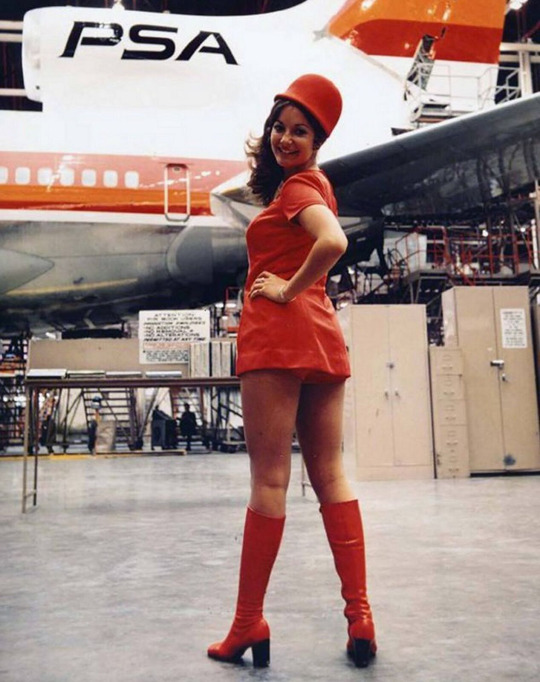
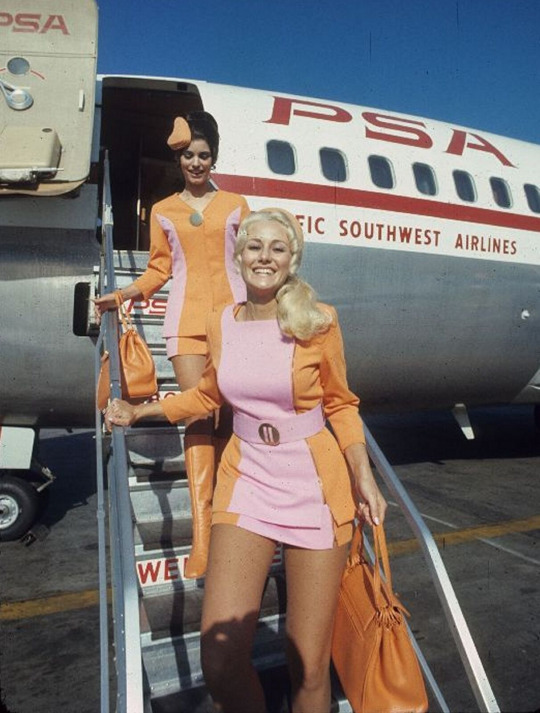
PSA stewardesses. I can't find an original source for either of these pictures, which have been widely spread without context or credit - although significant effort has been made to archive PSA's promotional content, a lot of it is, sadly, free-floating orphaned bits.
PSA's stewardesses wore bright pink and orange uniforms of miniskirts, hot pants, and go-go boots. They were encouraged to joke around with passengers, and so were the pilots. Other airlines at the time were still only slowly losing the unapproachable aura they had cultivated of stiff, sterile luxury and gravitas. PSA would get you where you needed to go without any fuss and they'd charge you half as much for it. And they weren't sloppy, either. Despite their low fares, PSA was incredibly safe, having one fatal accident in a span of time where American Airlines had 16, and even though nostalgia is obviously a factor I've only ever heard glowingly positive accounts of PSA, its service, and its staff.
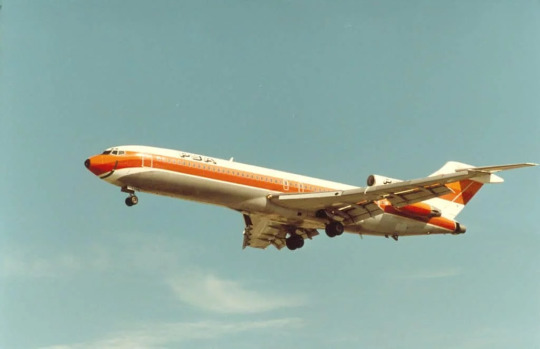
image: Bill Larkins
PSA's fleet was...eclectic. Though they operated a few very popular models, like the Boeing 727 and McDonnell Douglas MD-80 series, a lot of their offerings were somewhat uncommon. The plane in my profile picture is one of their two L-1011 TriStars, another of Lockheed's underappreciated airliners and by far the most advanced wide-body aircraft of its time. PSA was unique in that it operated a jumbo jet, their "Mother Grinningbird", on a route that was not just domestic, but intrastate. They also apparently operated a single Bell 206 helicopter, which I can find no additional clarification on. Lastly, they flew one of the oddest airliners ever built in both function and appearance, the British Aerospace 146.
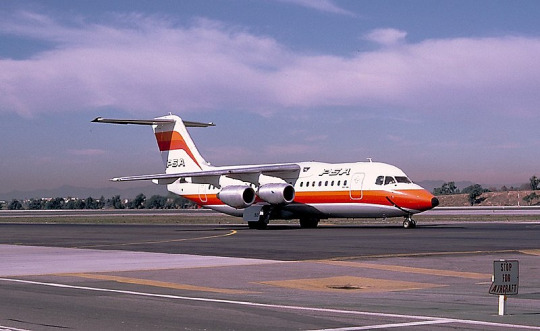
Just your regular high-wing jet. No thrust reversers necessary. Western-made but rocking the Il-76 wing anhedral. Super quiet because the powerplants are based off what you'd put on a helicopter. Seats less people than a 737-200 - six-across layout for maximum discomfort - and flies exclusively puddle jumps...yeah, I think four sounds like the right number of engines. image: Ted Quackenbush
Across all these planes, they found a livery that worked and they kept going with it. The reason this post is so long is to give context to just how important this livery is. The grinningbirds were what started low-cost carriers, paving the way for the silly names of jetBlue airplanes in a future its founders couldn't even have imagined. The shift to approachability over prestige in airline marketing was PSA's lasting gift to aviation, as were the low fares and the knowledge that a 'budget' airline didn't have to be dodgy or unpleasant - they just had to charge less than TWA and Western.
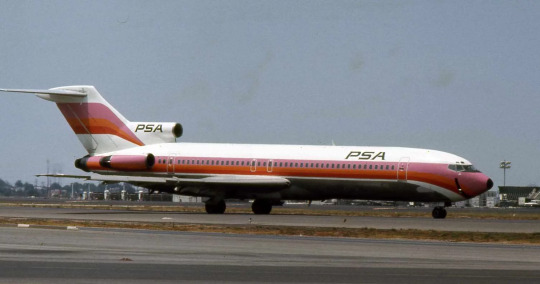
image: Piergiuliano Chesi
PSA's colorscheme was incredibly vibrant. The red and orange colors feel warm and tropical, complementing the California sunshine in which these planes spent their time. Earlier liveries also had a shocking hot pink shade above both, though it was eventually painted over due to issues with paint fading - I think the livery is vastly improved with its presence, but I suppose needs must. Despite the airline serving commuters more than vacationers it puts one in mind of things like beaches and ice cream stands - warm, high-energy things. The sorts of things one might smile about, if they like those things. I hate those things, but these planes make me like the idea of them, because they're just so darn happy to take me there!
The design of the fuselage is incredibly bold despite not using much more paint than any other airline of the day. While the striking colors definitely contribute to the overall look being more than the sum of its parts, I think there's also a few bits of clever design that really elevate the design of the plane.

The tail has a design almost like an inverse hockey-stick. Instead of following the cheatlines for maximum sleekness it chooses to diverge from it, creating a sharp angle that keeps the aerodynamic feeling while feeling fresh from similar designs of the time. By having the thin line from the tail trailing down towards the fuselage it prevents the block of empty space on a regular hockey-stick livery, where the forward portion of the empennage is fully unpainted, and creates a feeling of continuous color and excitement while keeping some staccato punch.
Similarly subtle yet effective are the stripes themselves. They aren't of an equal width - rather, the red stripe is thinner than the orange one, and in planes with the additional pink stripe this one is even wider. It feels a lot more dynamic than simple even-width stripes, feeling almost as if you can see the colors start to mix into each other. The 'mixing' feeling is helped by the fact that the cheatlines wrap under the nose instead of simply ending where they meet. The small painted white line under the main colored ones, above the unpainted metal of the underbelly, creates basically an extra two stripes for the price of one despite being so subtle many people probably didn't notice it.
On its own, the design of the bodies of PSA planes is already good, but it practically ceases to matter when you get to the face.

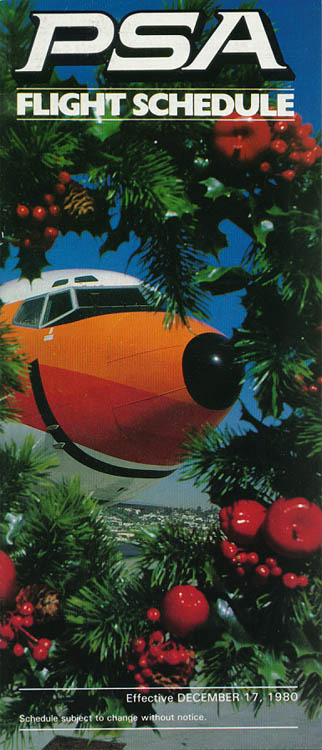
The way the top line of color wraps around the back of the cockpit windows makes it look almost like the plane is wearing sunglasses. And then there's the little painted black nose and, of course, the huge ear-to-ear grin. I don't really know what else to say about this because it's all been said time and time again.
I genuinely don't know how else to express it. PSA's livery was gorgeous and it was perfect for PSA. In all honesty, I don't think it's possible to improve it at all. My one slight criticism is that the actual PSA wordmark, though designed well, is a bit small and out of the way, but to be totally honest it's barely necessary. You see the smile and you know exactly who that plane is flying for.
PSA gets a PSA+.
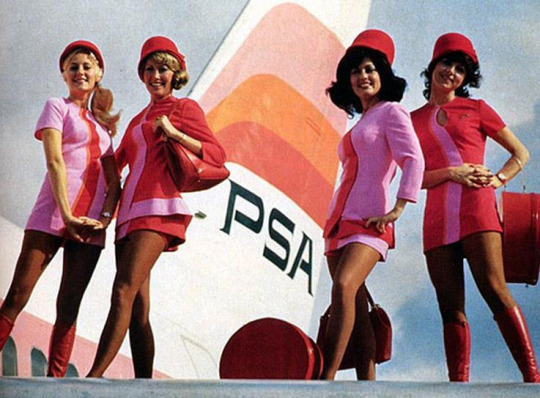
So what happened to PSA, if they were so successful? Did an economic shift catch them off-guard? Did some demographic evolution rob them of their old customer-base? Did a change of management result in a new owner running the airline into the ground? Did it have anything to do with the fact that the one time they were involved in an accident it spent eight months as the deadliest crash in US history?
Nope. They got bought out by USAir because they wanted more routes on the West Coast.
Yeah. That's the story. Neither a bang nor a whimper. They left one morning and didn't come back. That was the end of PSA, the first-ever low-cost carrier, California's most beloved airline, and one of the best-designed liveries in airline history if not the very best.
There is, however, one final twist. USAir eventually was sucked into the gaping maw of American Airlines. With this merger American Airlines also inherited the rights to PSA's IP. In classic fashion, they created a wholly-owned subsidiary by the name of PSA Airlines, just to make sure nobody else could get the trademark.
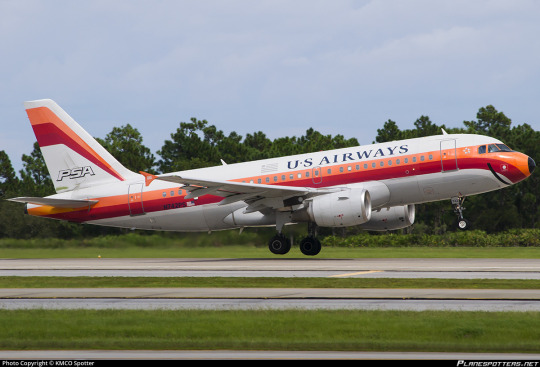
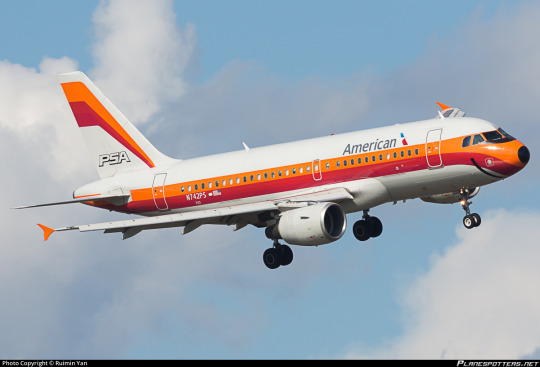
Under the iron fist of first US Airways (USAir's eventual rebrand) and later American Airlines, we were allowed one last grinningbird - an Airbus A319-100 registered N742PS. It's strange, seeing the PSA livery on a model of airplane they never operated. It's a rare example of the design on airframes that have that rather distinct 'default' modern empennage, all sharp and tall with no t-tail or third engine. The implementation could take some notes and the colors look bizarrely plastic, but I will never stop loving her no matter how much they take from her. How could I not, with that smile?
Unfortunately, in April of this year she was re-painted to a standard American Airlines livery. Although the Allegheny and Piedmont heritage liveries were removed at the same time, I almost don't even notice their absence because of the loss of our very last holdout from a much more colorful time and place. Part of me feels a sort of ripping-the-bandaid-off relief at it. American Airlines shouldn't get to parade around the skin of a much better livery worn by a much better airline. That isn't theirs; they didn't earn it. And there's no way to rebuild PSA now that times have changed and the industry is unrecognizable from the days when a ticket from San Diego to Burbank cost $9.99. All the same, the loss of yet another smile hurts. There's no way it wouldn't. And at the end of the day it makes me feel a little dead inside just imagining the mindset of the American Airlines executive who walked by her in the hangar and instead of smiling back gave the order to paint her white. And that day, the sky got a little less colorful and a lot sadder.
Maybe, in a strange sense, the way it happened is better. Nobody ran PSA into the ground. They did not cause some sort of reputation-ruining accident through willful negligence. Their customer service did not decline until they were widely grumbled about. They didn't die infamous for poor safety and loose morals like Pan Am, or splitting at the seams and betraying their reputation like Chalk's Ocean Airways. No, I don't think an organic shriveled going-under would have held any more dignity than this. I think the ending PSA got is as graceful as the ending to something like PSA could be. There is no end to the glory days which forces itself into our memories. There is no decline. No sunset to fly off into. There is a loss to mourn, but no accompanying moment to curse. Lost at sea, ship never found, nothing to imply a terrible fate; all we know is the poor sailors aren't here anymore.
Maybe it's not universally known to people who aren't interested in subjects that bring them close to it, but to those of us who love planes PSA is truly special. Its quiet apotheosis has made it synonymous with the very best an airline could be. The joy of a time where a regular person could finally afford their first plane ticket and be greeted by colorful people who talk to them like friends, where even the planes are smiling, is encoded into the DNA of PSA's remnants, into every anecdote told by an aging former stewardess and into every Polaroid taken of one of those smiling planes parked on a sunny California tarmac. It was there, and then it was a distant echo of warm breezes and idle chatter that feels almost close enough to reach out and touch. PSA never died. One day it was flying passengers to their destinations, planes smiling their same smiles. The next day it was fond memory, already graduated to the distant sunny shores of nostalgia.
youtube

#tarmac fashion week#grade: a+#region: north america#region: united states#era: 1960s#era: 1970s#era: 1980s#pacific southwest airlines#requests#defunct airlines#regional airlines#double sunrise#long haul#galley gala
107 notes
·
View notes
Text

airsLLide No. 11535: N952WP, Boeing 737-3B7, Western Pacific, Colorado Springs, February 7, 1996.
The short-lived low-cost carrier Western Express was undoubtedly a unique player in the ever-changing US domestic market. Not for its fleet, not for its fares, nor for its routes, but for its looks. It was literally the airline where every single aircraft looked differently. That made the airline literally the aircraft spotter's magnet of the period.
Among the attempts to become a profitable and successful player, the Colorado Springs-based airline chose to go the way many transit companies around the globe choose to earn the extra buck: by selling their skin, i.e. by acquiring full size marketing on the exterior of their vehicles, ehm, in this case, airplanes. While Western Pacific had some planes in a standard brand of its own, the majority of their Boeing 737-300s featured unique promitional liveries. N352WP was certainly among the most popular of these designs, with the soaring eagle of the local Colorado Tech college catching many an eye on every airport it appeared.
The extra money earned from the promotional liveries was obviously not enough to get the airline past the intial years: Formed in 1994, the carrier started trading in spring 1995, but soon got into a devastating competition with United Airlines running a hub in nearby Denver, CO. In 1997, an attempt was made to merge the business with Frontier Airlines, but the deal was then halted due to the dire financial situation of the colorful newcomer, and Western Pacific had to file for bankruptcy and cease trading in February 1998.
3 notes
·
View notes
Text

Boeing 767-300 Australian Airlines
Registration: VH-OGV Type: 767-338ER Engines: 2 × GE CF6-80C2B6 Serial Number: 30186 First flight: Jun 6, 2000
Australian Airlines is an international, full-service, economy leisure airline operating in the early 2000s. It was a subsidiary of Qantas, with its main hub at Cairns Airport and a secondary hub in Sydney.
Australian Airlines began its operations in 2002, using the name of its predecessor, the former carrier of Australia in the middle of the 20th century. The original airline, Australian Airlines, was acquired by Qantas on September 14, 1992. Formerly known as Trans Australia Airlines, but changed its name in 1986, the company has served domestic flights in the country since 1946. During the takeover process, much of the corporate identity of the former Australian Airlines was replaced by elements of the Qantas brand. So, the waiting room "Australian Flight Deck" turned into "Qantas Club", and the on-board magazine "Australian Way" was renamed "Qantas" magazine.
Between 2002 and 2006, Qantas revived the "Australian Airlines" brand to serve the low-cost travel market for tourists to and from Australia throughout Southeast Asia. The aircraft used were Qantas Boeing 767-338ERs, which were painted in new bright orange liveries with the word "Australian" written on them.
Australian Airlines ceased operations under this brand on 30 June 2006, but continued to operate flights for Qantas on a wet lease basis. This meant that Australian Airlines operated flights for Qantas using its own crews, but under the "Qantas" brand. Qantas later decided to abandon the public use of the "Australian Airlines" brand in favour of "Jetstar" as its low-cost holiday carrier. Qantas and Jetstar took over the services on Australian Airlines routes, and Jetstar International was launched in late 2006 to help expand the Qantas Group's international presence in Asia.
At the time of its demise, Australian Airlines had a fleet of five Boeing 767-300ER aircraft.
Poster for Aviators aviaposter.com
6 notes
·
View notes
Text
A federal judge Tuesday blocked JetBlue Airways’ purchase of Spirit Airlines after the Justice Department sued to stop the merger, saying the deal would drive up fares for price-sensitive consumers by taking the discount carrier out of the market. JetBlue’s proposed $3.8 billion purchase of discounter Spirit would have produced the country’s fifth-largest airline, a deal the carriers had said would help them better grow and compete against larger rivals like Delta and United. “JetBlue plans to convert Spirit’s planes to the JetBlue layout and charge JetBlue’s higher average fares to its customers,” U.S. District Court Judge William Young wrote in his decision. “The elimination of Spirit would harm cost-conscious travelers who rely on Spirit’s low fares.” The decision, handed down Tuesday, marks a victory for a Justice Department that has aggressively sought to block deals it views as anti-competitive. “Today’s ruling is a victory for tens of millions of travelers who would have faced higher fares and fewer choices had the proposed merger between JetBlue and Spirit been allowed to move forward,” Attorney General Merrick Garland said in a statement. “The Justice Department will continue to vigorously enforce the nation’s antitrust laws to protect American consumers.”
8 notes
·
View notes
Text
Amazon deliveries could be headed for some turbulence in the new year. Pilots for US-based Air Transport International, a cargo airline that ferries Amazon packages from its fulfillment centers to airports nearer to its customers, voted to authorize a strike last month. During the three and a half years the union has been negotiating with ATI, wages in the industry have soared, and ATI’s pilots complain that their pay has fallen behind. Meanwhile, they say ATI is facing record attrition as pilots jump ship to better-paying carriers.
A strike could throw a wrench in Amazon’s logistics network. ATI, owned by holding company ATSG, operates half of the 80 US aircraft currently in service for Amazon, according to an estimate by Planespotters. But the pilots, who are represented by the Air Line Pilots Association union, can’t walk out until at least next year.
Federal law requires airline labor disputes to be mediated by the US government’s National Mediation Board, which will implement a 30-day cooling-off period if it determines the parties have reached an impasse and they refuse arbitration. If a resolution isn’t reached during that time, the pilots can walk off the job or the airline can lock them out. Some 98 percent of ATI’s 640 pilots participated in the vote and only one didn’t vote to authorize the strike.
Amazon outsources the operation of its air service, which it calls Amazon Air, to a small network of cargo airlines whose pilots fly Amazon-branded planes. In the US alone, they collectively operate more than 330 daily flights for Amazon between more than 50 airports, according to the logistics consultancy MWPVL International.
Most airlines that work with Amazon also devote a large share of their businesses to transporting cargo for other customers, including DHL and the US military. In recent years, ATI has gone all-in on the retailer, however. Amazon deliveries now comprise 94 percent of ATI’s flying hours, according to the pilots’ union, making the company and its workers dependent on the ecommerce giant.
ATI’s pilots’ union says that more than a third of the airline’s pilots have left so far this year, after 27 percent of them departed last year. The union says 42 percent of its pilots are currently on probation, meaning they’re in their first year of service. “We’re watching our carrier disintegrate,” says Mike Sterling, chair of the ATI pilots’ union.
The pilots’ union says they have delivered a 98 percent on-time performance rate, but the rapid turnover and declining experience levels are threatening that. “This market is highly competitive, and ATSG is diminishing its ability to provide quality service to Amazon,” says Sterling. “We think this is a conversation that needs to be had between all three parties.” Amazon and ATI did not respond to requests for comment. During an earnings call in May, ATSG’s former CEO said that ATI’s service quality remained outstanding, but acknowledged that training replacements for departing pilots had raised costs for the airline.
When the pilots’ union negotiated a contract with the company in 2018, pilots’ pay, benefits, and schedules were competitive with similar airlines, says Josh Hoy, a captain who started at the airline seven years ago. He initially looked at the job as just a stepping stone but decided to stick around when ATI’s relationship with Amazon took off. “It was a really exciting time, being on the ground floor of that kind of growth,” he says. “I started to have the conversation with my wife and said, ‘I think this might be the place to stay.’”
However, “as time went on, we’ve fallen far behind,” Hoy says. ATI’s union says its pilots are paid less on an hourly basis than those at all of Amazon’s seven other carriers. “We operate under the same rules, in the same airspace, on the exact same routes. The airplanes cost the exact same to operate,” says Hoy. “Everything is exactly the same, except for our pay.”
No Fondness for Labor
Amazon generally goes to great lengths to avoid engaging with unions and to deter its employees or those who work for its contractors from joining them. The company spent the last year and a half unsuccessfully challenging the first and only union victory at a US Amazon warehouse. When employees of a delivery contractor in Southern California unionized earlier this year, Amazon refused to jointly bargain with the workers and terminated its agreement with the contractor. “Amazon has not demonstrated a real fondness for labor,” Sterling acknowledges. “I would love to change that narrative with them.”
The last and only time Amazon faced a strike by one of its air carriers was in 2016, during the early days of its air cargo operation, when 250 pilots for ABX Air walked off the job. A judge deemed the strike illegal, however, and ordered the pilots back to work the following day. Nonetheless, a former Amazon Air employee told WIRED last year that Amazon suspended its business with ABX for several weeks after the strike ended to demonstrate the relative power it held in the relationship, which soon soured.
ATI’s pilots are taking a less antagonistic tone in hopes of bringing Amazon to the negotiating table. “What we don’t want to do is affect our customers,” says Sterling. “We’ve done a lot to protect our obsession with Amazon.” However, he says the intransigence of ATSG’s management has left the pilots with no choice but to call a strike.
“This side of Amazon’s network is the most vulnerable to labor strikes,” says Marc Wulfraat, president of logistics consultancy MWPVL. If drivers or warehouse workers strike, the company can shift the flow of products and packages to one of its many nearby warehouses, but airports are fewer in number and farther apart.
Amazon could compensate for a walkout at ATI by shifting volume to other air carriers under the Amazon Air umbrella, but only if they have the capacity to handle the influx at all of the airports. It could also transport some of its packages by truck instead, which it did during the brief 2016 strike. However, this could result in slower shipping times and reduced service, says Wulfraat, which flies in the face of Amazon’s mantra of customer obsession.
Pilots also have the advantage of being generally in a strong position across the airline industry. “It’s still a very, very hot job market” for pilots, says Geoff Murray, a partner who works on aerospace at management consultancy Oliver Wyman. Plummeting demand for passenger pilots during the pandemic sent many into early retirement, worsening an existing pilot shortage that got more acute as the industry bounced back. Wages have soared. Oliver Wyman estimates that captains’ pay at the US mainline carriers, such as Delta and UPS, has increased 46 percent since 2020, while regional carriers have increased pay by 86 percent.
Pilot Drew Patterson came to ATI in 2021, attracted by the work-life balance the airline offered, but as the carrier lost pilots, he has seen his workload creep up and his schedule become more unpredictable. With fewer crews to operate the same number of flights, “everybody else's schedule gets compressed,” he says. “Sometimes you can be away from home for a long time.”
Long-term, he thinks Amazon’s continued growth should be a good thing for ATI and its employees, so he’s been willing to stick it out. But he’s not so sure all of his colleagues will feel the same about current conditions at the company.
“All of this has a real house-of-cards feeling to it,” says Sterling. “We just can’t sustain what we’re doing.”
11 notes
·
View notes
Text
WestJet will wind down Sunwing Airlines and integrate the low-cost carrier into its mainline business within two years as part of a strategy to streamline operations amid fierce competition. The move, announced in an internal memo obtained by The Canadian Press, has raised questions among some industry observers about the impact on airfares and travellers' flight options. Sunwing Airlines president Len Corrado said in the memo the change will open up markets for the 18-year-old company as well as its workers. "WestJet will eventually move to a one jet aircraft operating certificate (AOC) model and Sunwing Airlines will be integrated into WestJet. This is a long-term move that will unlock greater scale and growth opportunities for our people, and specifically for our airline employees within the group," Corrado said in the memo, dated Wednesday. [...]
Continue Reading.
Tagging: @politicsofcanada
13 notes
·
View notes
Text
Aircraft Engine Test Cells Market Investment Trends and Market Expansion to 2033
Introduction
The global aircraft engine test cells market is experiencing significant growth, driven by increasing air traffic, advancements in engine technology, and stringent safety regulations. Aircraft engine test cells are specialized facilities used to test and evaluate the performance, efficiency, and safety of aircraft engines before they are installed in aircraft. As the aviation industry continues to expand, the demand for high-performance, reliable engine testing solutions is expected to rise. This article provides an in-depth analysis of the industry trends, market dynamics, and forecasts for the period 2024–2032.
Download a Free Sample Report:-https://tinyurl.com/46d2xfhz
Market Dynamics
Market Drivers
Growing Air Traffic and Fleet Expansion The increasing number of air passengers and cargo transport has led to a surge in new aircraft production, boosting demand for engine test cells.
Advancements in Engine Technology Modern aircraft engines are becoming more fuel-efficient and environmentally friendly, requiring sophisticated test cells for performance validation.
Stringent Regulatory Standards Aviation authorities worldwide impose strict regulations on engine testing, compelling airlines and manufacturers to invest in advanced testing infrastructure.
Rising Demand for MRO Services The maintenance, repair, and overhaul (MRO) sector plays a crucial role in aircraft safety, leading to an increased need for engine test cells in repair facilities.
Market Challenges
High Capital Investment Setting up an aircraft engine test cell involves significant costs related to infrastructure, technology, and maintenance.
Environmental Concerns Aircraft engine testing generates emissions and noise pollution, leading to regulatory scrutiny and the need for eco-friendly solutions.
Technical Complexity The integration of modern technology into engine test cells requires skilled labor and expertise, posing a challenge for some regions.
Market Opportunities
Integration of AI and Automation The adoption of AI and automation in test cells can enhance efficiency, reduce human error, and optimize engine testing.
Expansion in Emerging Markets Developing regions, such as Asia-Pacific and Latin America, are witnessing growth in aviation infrastructure, creating opportunities for test cell providers.
Focus on Sustainable Aviation The push towards greener aviation fuels and electric propulsion presents opportunities for specialized test cells catering to next-generation engines.
Market Segmentation
The aircraft engine test cells market can be segmented based on several factors:
By Engine Type:
Turbofan Engines
Turboprop Engines
Turbojet Engines
Piston Engines
By End User:
Commercial Airlines
Military and Defense
MRO Providers
OEMs (Original Equipment Manufacturers)
By Test Cell Type:
Indoor Test Cells
Outdoor Test Cells
By Region:
North America
Europe
Asia-Pacific
Latin America
Middle East & Africa
Regional Analysis
North America
North America dominates the aircraft engine test cells market, primarily due to the presence of major aircraft manufacturers, MRO facilities, and military aviation projects. The U.S. leads the region with heavy investments in engine testing and innovation.
Europe
Europe follows closely, with countries like Germany, the UK, and France investing heavily in aerospace technology. The presence of companies such as Rolls-Royce and Safran contributes to market expansion.
Asia-Pacific
The Asia-Pacific region is experiencing the fastest growth, driven by rising airline fleets, increasing air travel demand, and government support for aviation infrastructure development. China and India are key contributors to the market expansion.
Latin America
Latin America is witnessing steady growth, supported by the expansion of low-cost carriers and improving aviation infrastructure in countries like Brazil and Mexico.
Middle East & Africa
The Middle East is a major hub for aviation due to its strategic geographic location and strong airline presence, particularly in the UAE and Saudi Arabia. Africa’s market growth is emerging, fueled by increasing aircraft acquisitions and maintenance needs.
Key Players in the Market
Several companies dominate the aircraft engine test cells market, including:
General Electric (GE) Aviation
Rolls-Royce Holdings
Safran SA
Honeywell International
Siemens AG
MDS Aero Support Corporation
National Aerospace Solutions
Pratt & Whitney (Raytheon Technologies)
These companies focus on R&D, strategic partnerships, and technological advancements to maintain their market position.
Future Trends and Forecast (2024–2032)
Increasing Digitalization in Engine Testing Digital twin technology and IoT integration will enhance the accuracy and efficiency of aircraft engine test cells.
Growth in Military Aviation Testing Governments worldwide are increasing defense spending, leading to greater demand for military aircraft engine testing solutions.
Adoption of Green Technologies Engine test cells will incorporate sustainable practices, such as noise reduction techniques and alternative fuel testing capabilities.
Expansion of MRO Capabilities With aircraft fleets aging, MRO providers will invest in advanced test cells to meet rising maintenance demands.
Conclusion
The aircraft engine test cells market is poised for significant growth, driven by advancements in aviation technology, regulatory compliance, and the rising need for reliable engine testing. While challenges like high investment costs and environmental concerns persist, opportunities in automation, emerging markets, and sustainable aviation offer a promising future for industry players. By adopting innovative solutions and expanding their global footprint, key stakeholders can capitalize on the dynamic growth of this sector in the coming years.Read Full Report:-https://www.uniprismmarketresearch.com/verticals/aerospace-defence/aircraft-engine-test-cells.html
0 notes
Text
Airline Ancillary Services Market Size, Trends and Growth, Forecast by 2025-2033

The Reports and Insights, a leading market research company, has recently releases report titled “Airline Ancillary Services Market: Global Industry Trends, Share, Size, Growth, Opportunity and Forecast 2025-2033.” The study provides a detailed analysis of the industry, including the global Airline Ancillary Services Market share, size, trends, and growth forecasts. The report also includes competitor and regional analysis and highlights the latest advancements in the market.
Report Highlights:
How big is the Airline Ancillary Services Market?
The global airline ancillary services market was valued at US$ 98.7 billion in 2024 and is expected to register a CAGR of 8.1% over the forecast period and reach US$ 198.9 billion in 2033.
What are Airline Ancillary Services?
Airline ancillary services refer to additional revenue-generating offerings beyond ticket sales, enhancing passenger experience and airline profitability. These services include baggage fees, seat selection, priority boarding, in-flight entertainment, Wi-Fi, meals, travel insurance, and loyalty programs. Low-cost carriers (LCCs) heavily rely on ancillary revenue, while full-service airlines also leverage these services to optimize margins. The rise of digital platforms and personalized travel experiences has further boosted the demand for ancillary services, making them a crucial part of modern airline business models.
Request for a sample copy with detail analysis: https://www.reportsandinsights.com/sample-request/2652
What are the growth prospects and trends in the Airline Ancillary Services industry?
The airline ancillary services market growth is driven by various factors and trends. The airline ancillary services market is experiencing significant growth, driven by increasing passenger demand for personalized travel experiences and airlines’ focus on maximizing revenue beyond ticket sales. Key offerings include baggage fees, seat selection, priority boarding, onboard meals, Wi-Fi, and loyalty programs, with digitalization enhancing accessibility and customization. Low-cost carriers (LCCs) dominate this market, but full-service airlines are also expanding ancillary services to boost profitability. The rise of e-commerce, dynamic pricing strategies, and AI-driven recommendations further fuel market expansion. North America, Europe, and Asia-Pacific are leading regions, with airlines continuously innovating to enhance customer engagement and revenue streams. Hence, all these factors contribute to airline ancillary services market growth.
What is included in market segmentation?
The report has segmented the market into the following categories:
By Service Type
Baggage Fees
On-Board Retail & A la Carte
Airline Retail
Frequent Flyer Program (FFP) Miles Sale
Others
By Carrier Type
Full-Service Carriers
Low-Cost Carriers
By Trip Purpose
Business Travel
Leisure Travel
By Service Delivery Method
In-Flight Services
Ground Services
North America
United States
Canada
Europe
Germany
United Kingdom
France
Italy
Spain
Russia
Poland
Benelux
Nordic
Rest of Europe
Asia Pacific
China
Japan
India
South Korea
ASEAN
Australia & New Zealand
Rest of Asia Pacific
Latin America
Brazil
Mexico
Argentina
Middle East & Africa
Saudi Arabia
South Africa
United Arab Emirates
Israel
Rest of MEA
Who are the key players operating in the industry?
The report covers the major market players including:
American Airlines
Delta Air Lines
United Airlines
Southwest Airlines
Ryanair
easyJet
Lufthansa
JetBlue Airways
Alaska Airlines
Air France-KLM
KALL MORRIS INC.
View Full Report: https://www.reportsandinsights.com/report/Airline Ancillary Services-market
If you require any specific information that is not covered currently within the scope of the report, we will provide the same as a part of the customization.
About Us:
Reports and Insights consistently mееt international benchmarks in the market research industry and maintain a kееn focus on providing only the highest quality of reports and analysis outlooks across markets, industries, domains, sectors, and verticals. We have bееn catering to varying market nееds and do not compromise on quality and research efforts in our objective to deliver only the very best to our clients globally.
Our offerings include comprehensive market intelligence in the form of research reports, production cost reports, feasibility studies, and consulting services. Our team, which includes experienced researchers and analysts from various industries, is dedicated to providing high-quality data and insights to our clientele, ranging from small and medium businesses to Fortune 1000 corporations.
Contact Us:
Reports and Insights Business Research Pvt. Ltd. 1820 Avenue M, Brooklyn, NY, 11230, United States Contact No: +1-(347)-748-1518 Email: sales@reportsandinsights.com Website: https://www.reportsandinsights.com/ Follow us on LinkedIn: https://www.linkedin.com/company/report-and-insights/ Follow us on twitter: https://twitter.com/ReportsandInsi1
#Airline Ancillary Services Market share#Airline Ancillary Services Market size#Airline Ancillary Services Market trends
0 notes
Text
Low-Cost Carrier Airlines Market: Redefining Air Travel
Low-cost carrier airlines, often known as budget airlines, have transformed the aviation industry by making air travel more affordable and accessible to a broader range of passengers. In this article, we will delve into the current landscape of the low-cost carrier airlines market, the factors contributing to its growth, and the promising future that lies ahead.
Low Cost Carrier Airlines Market Introduction
Low-cost carrier airlines have disrupted the traditional aviation model, offering passengers affordable fares while maintaining efficiency and profitability. These airlines have redefined air travel, making it a popular choice for both leisure and business travelers.
The Current State of the Low-Cost Carrier Airlines Market
1. Affordability
Low-cost carriers are known for their competitive pricing. They offer no-frills, point-to-point service, allowing passengers to pay only for the services and amenities they need, avoiding unnecessary fees.
2. Network Expansion
While initially focused on short-haul routes, many low-cost carriers have expanded their networks to include long-haul destinations. This expansion has broadened their customer base, attracting travelers looking for budget-friendly international flights.
3. Operational Efficiency
Low-cost carriers have streamlined their operations to reduce costs. Their operational efficiency includes quick turnarounds between flights, utilizing secondary airports, and operating a single aircraft type, which simplifies maintenance and training.
4. Passenger Experience
While low-cost carriers offer basic services, passengers can often choose to add amenities for an additional fee. This a-la-carte approach allows travelers to personalize their flying experience.
5. Market Share
Low-cost carriers have gained a significant market share in regions like Europe, the United States, and Southeast Asia. They are increasingly competing with legacy carriers and dominating certain markets.
Low Cost Carrier Airlines Market Analysis
The low-cost carrier market is experiencing substantial growth, with key insights into its current status:
1. Market Size
The global low-cost carrier market is estimated to be valued at over $130 billion in 2023 and is projected to continue expanding. This growth is driven by increasing consumer demand for budget-friendly travel options.
2. Regional Trends
Low-cost carriers are popular in various regions, with different brands dominating specific markets. For example, Europe has Ryanair and easyJet, while the United States has Southwest Airlines and Spirit Airlines.
3. Key Players
Major players in the low-cost carrier sector include Southwest Airlines, Ryanair, AirAsia, and JetBlue. These airlines have played a crucial role in shaping the industry's development.
Low Cost Carrier Airlines Future Prospects
The future of the low-cost carrier airlines market is marked by several exciting developments:
1. Continued Expansion
Low-cost carriers will continue to expand their networks, offering more routes and services. This expansion may include more long-haul flights to various international destinations.
2. Technological Advancements
Airlines will invest in technology to improve customer service and enhance operational efficiency. This includes mobile apps, self-service kiosks, and improved in-flight connectivity.
3. Sustainability
The industry is increasingly focusing on sustainability by investing in fuel-efficient aircraft and exploring alternative fuels to reduce their environmental impact.
4. Market Competition
Competition in the low-cost carrier market is expected to intensify, as both new and established airlines vie for market share. This will lead to innovative pricing and service strategies.
0 notes
Text

Record demand for flights across the Atlantic has pushed British Airways and parent group International Airlines Group (IAG) to new profit highs, a time of strong growth and recovery. British Airways, the IAG flagship airline, was a major contributor to the group's profit success, making a major contribution to a record year. IAG announced a post-tax profit rise to €2.73 billion (£2.26 billion) for 2024. This is a robust turnaround from last year, with operating profits jumping by 22% to €4.3 billion (£3.55 billion). The continued rebound in passenger levels, after the slump triggered by the Covid-19 pandemic, has been the key driver behind this financial improvement. The airline sector, which took unprecedented hits when the world's health crisis worsened, has been experiencing renewed growth as people began to move around again as restrictions were eased and consumer sentiment recovered. British Airways has leveraged this bounce back by revamping its service and increasing transatlantic frequencies, a savvy decision that has been extremely profitable. Traffic on routes between North America and Europe has continued to be exceptionally high, with corporate and leisure travel alike keen on reconnecting internationally. Juergen Lehle, CC BY-SA 3.0 http://creativecommons.org/licenses/by-sa/3.0/, via Wikimedia Commons Industry experts credit such performance to a mix of strategic investments and operational enhancements. IAG has centered on maximizing fleet efficiency, enhancing customer service, and fine-tuning pricing tactics to respond to the changing travel landscape. British Airways' investment has been prominently seen in renovated cabins, enhanced in-flight experience, and simplified operations that target minimizing delays and enhancing overall customer satisfaction. One of the main drivers for the financial growth has been the strong performance by long-haul routes, particularly transatlantic flights. British Airways has taken advantage of solid demand on London-to-major American cities like New York, Los Angeles, and Miami routes. The airline's premium products such as first class and business class have recorded strong occupancy levels, indicating a transition in passenger taste towards comfort and luxury experiences during the post-pandemic era. In spite of adversity in the form of volatile fuel prices, economic unpredictability, and persistent competition from low-cost carriers, British Airways and IAG have managed the environment well. Dynamic pricing and cost-containment measures have allowed the airline group to balance revenue maximization with service quality. In addition, IAG's portfolio of other major European carriers, including Iberia, Aer Lingus, and Vueling, has offered a cushion against market fluctuations. The combined resilience of these carriers has enabled IAG to achieve a competitive position in the airline industry, leveraging synergies and operational efficiencies to enhance profitability. Ahead, British Airways and IAG are likely to continue benefiting from the rebound in travel demand. The group of airlines is seeking greater opportunities to expand, especially in developing economies, while also investing in aviation sustainable initiatives. With growing pressure to cut carbon emissions, British Airways has pledged to invest in greener technologies, such as developing sustainable aviation fuels and more efficient aircraft. The revival of transatlantic flights heralds a wider trend in the airline sector, with carriers around the world seeing international travel pick up again. Uncertainties do exist, as they do over geopolitical events and global economic trends, but the robust earnings of British Airways and parent group IAG reflect a dramatic turnaround from the depths of the pandemic collapse. Customers have proved willing to give travel top billing, with latent demand finding its way into elevated ticket sales and premium service expenditure. British Airways, with its strong brand presence and strategic location, is well-positioned to take advantage of this trend and continue its upward trajectory in the future. With the aviation industry constantly changing, British Airways and IAG's success story is an indication of the industry's resilience and the scope for further growth, as long as airlines learn to keep up with shifting consumer trends, green issues, and technological innovations. The recent financial performance not only represents a milestone for British Airways but also serves to further consolidate the airline as a major force in international aviation, driving the future of air travel through innovation, investment, and strategic expansion. Read the full article
0 notes
Text
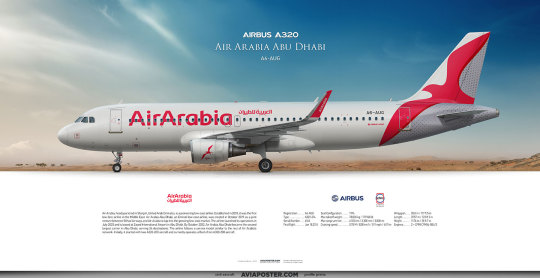
Airbus A320 Air Arabia Abu Dhabi
Registration: A6-AUG Type: A320-214 Engines: 2 × CFMI CFM56-5B4/3 Serial Number: 6166 First flight: Jun 18,2014
Air Arabia was founded in February 2003, and began operations in October of the same year. It became the first low-cost airline in the Middle East. The company's head office is located in the Sharjah Freight Center building, at the Sharjah International Airport, United Arab Emirates.
It was a time of rapid growth for the largest airlines in the Persian Gulf. In November 2003, Etihad, the flagship carrier of the emirate of Abu Dhabi, made its first flight. Sixteen years later, in the fall of 2019, Etihad, already world–famous, partnered with Air Arabia to establish its own low-cost airline, Air Arabia Abu Dhabi. This happened two years after the state-owned Etihad launched a five-year transformation plan.
In the spring of 2020, the new airline Air Arabia Abu Dhabi received an operator's certificate from the General Directorate of Civil Aviation of the UAE. At that time, the airline had not yet determined an exact launch date due to flight restrictions during the pandemic. Under the agreement with Etihad, Air Arabia supports the network of destinations provided by the flagship, and in return gets access to the growing low-cost airline market. In May 2020, the newly formed airline started its operations with only two Airbus A320 aircraft.
Currently, Air Arabia Abu Dhabi is based at Abu Dhabi Sheikh Zayed International Airport and has a fleet of 10 Airbus A320 aircraft. There were also competitors in the face of another low–cost airline, Wizz Air, which has 12 A321 aircraft based at the same airport. A serious competitor, but as the Arabic saying goes, "The residents of the house know better what is inside." Just two years later, Air Arabia Abu Dhabi became the emirate's second largest airline, serving 24 destinations.
Poster for Aviators aviaposter.com
2 notes
·
View notes
Text
Polymethyl Methacrylate (PMMA) Aviation Plastic Market, Global Outlook and Forecast 2025-2032
Polymethyl Methacrylate (PMMA) Aviation Plastic refers to a high-performance thermoplastic material widely used in the aviation industry for various applications such as aircraft windows, canopies, cabin dividers, and instrument panels. PMMA is prized for its excellent optical clarity, lightweight nature, and resistance to UV radiation and impact. This material is extensively utilized in both commercial and military aircraft due to its durability and high weather resistance.
Market Size
Download FREE Sample of this Report @ https://www.24chemicalresearch.com/download-sample/287413/global-polymethyl-methacrylate-aviation-plastic-forecast-market-2025-2032-483
The global Polymethyl Methacrylate (PMMA) Aviation Plastic market was valued at USD 4,580 million in 2023 and is projected to reach USD 6,618.35 million by 2030, reflecting a compound annual growth rate (CAGR) of 5.40% during the forecast period. North America accounted for USD 1,193.42 million in 2023, growing at a CAGR of 4.63% from 2024 to 2030. The steady growth of the market can be attributed to increasing aircraft production, rising demand for lightweight materials, and the expansion of the aerospace industry across emerging economies.
Market Dynamics
Drivers
Rising Demand for Lightweight and Fuel-Efficient Aircraft
The aviation industry is increasingly adopting lightweight materials like PMMA to improve fuel efficiency and reduce carbon emissions.
The aviation industry is increasingly adopting lightweight materials like PMMA to improve fuel efficiency and reduce carbon emissions.
Growing Commercial Aviation Sector
The surge in air travel demand, especially in Asia-Pacific, is fueling aircraft manufacturing, leading to a higher demand for PMMA aviation plastics.
The surge in air travel demand, especially in Asia-Pacific, is fueling aircraft manufacturing, leading to a higher demand for PMMA aviation plastics.
Advancements in Material Technology
Innovations in PMMA formulations, such as improved impact resistance and scratch resistance, are enhancing the adoption of these materials in aerospace applications.
Innovations in PMMA formulations, such as improved impact resistance and scratch resistance, are enhancing the adoption of these materials in aerospace applications.
Stringent Safety and Environmental Regulations
Regulatory bodies like the FAA and EASA mandate the use of materials that comply with safety and environmental standards, further driving the demand for PMMA in aviation.
Regulatory bodies like the FAA and EASA mandate the use of materials that comply with safety and environmental standards, further driving the demand for PMMA in aviation.
Restraints
High Production Costs
The cost of manufacturing PMMA aviation plastics remains a challenge due to expensive raw materials and processing techniques.
The cost of manufacturing PMMA aviation plastics remains a challenge due to expensive raw materials and processing techniques.
Availability of Substitutes
Alternative materials such as polycarbonate and acrylic blends pose competition to PMMA.
Alternative materials such as polycarbonate and acrylic blends pose competition to PMMA.
Supply Chain Disruptions
Geopolitical tensions, trade restrictions, and raw material shortages can impact market growth.
Geopolitical tensions, trade restrictions, and raw material shortages can impact market growth.
Opportunities
Expansion of Low-Cost Airlines
The growth of budget carriers in developing regions presents significant opportunities for PMMA aviation plastic manufacturers.
The growth of budget carriers in developing regions presents significant opportunities for PMMA aviation plastic manufacturers.
Increasing Investments in Military Aviation
Military aircraft modernization programs are driving demand for high-performance plastics.
Military aircraft modernization programs are driving demand for high-performance plastics.
Advancements in Recycling and Sustainable PMMA Materials
The development of eco-friendly PMMA variants can create new growth avenues.
The development of eco-friendly PMMA variants can create new growth avenues.
Challenges
Complexity in Recycling PMMA
The recycling process for PMMA aviation plastics is complex, limiting its adoption in sustainable aviation.
The recycling process for PMMA aviation plastics is complex, limiting its adoption in sustainable aviation.
Regulatory Compliance Issues
Strict aviation industry regulations often require costly testing and certifications.
Strict aviation industry regulations often require costly testing and certifications.
Regional Analysis
North America
The largest regional market, driven by strong aerospace manufacturing industries in the U.S. and Canada.
Major aircraft manufacturers like Boeing and Lockheed Martin significantly contribute to market growth.
The largest regional market, driven by strong aerospace manufacturing industries in the U.S. and Canada.
Major aircraft manufacturers like Boeing and Lockheed Martin significantly contribute to market growth.
Europe
Presence of leading aerospace companies such as Airbus and Rolls-Royce.
Stringent EU regulations on emissions are encouraging the adoption of lightweight materials like PMMA.
Presence of leading aerospace companies such as Airbus and Rolls-Royce.
Stringent EU regulations on emissions are encouraging the adoption of lightweight materials like PMMA.
Asia-Pacific
Rapidly growing aviation sector, with major demand coming from China, India, and Southeast Asia.
Increasing domestic aircraft production is boosting the market.
Rapidly growing aviation sector, with major demand coming from China, India, and Southeast Asia.
Increasing domestic aircraft production is boosting the market.
Latin America and Middle East & Africa
Moderate growth due to expanding aviation infrastructure and rising demand for air travel.
Moderate growth due to expanding aviation infrastructure and rising demand for air travel.
Competitor Analysis
The global PMMA Aviation Plastic market is moderately consolidated, with key players focusing on strategic partnerships, R&D investments, and product innovations to gain a competitive edge.
Key Players:
Mitsubishi Chemical Corporation
Arkema SA
Röhm GmbH
Evonik Industries AG
Trinseo S.A.
Sumitomo Chemical Co., Ltd.
Mitsubishi Chemical Corporation
Arkema SA
Röhm GmbH
Evonik Industries AG
Trinseo S.A.
Sumitomo Chemical Co., Ltd.
Market Segmentation (by Application)
Global Polymethyl Methacrylate (PMMA) Aviation Plastic Market is segmented by application into:
Aircraft Windows & Canopies
Cabin Interiors
Cockpit Instruments
Light Covers
Other Aerospace Components
Aircraft Windows & Canopies
Cabin Interiors
Cockpit Instruments
Light Covers
Other Aerospace Components
Market Segmentation (by Type)
The market is segmented based on type as follows:
Cast Acrylic Sheet
Extruded Acrylic Sheet
Others
Cast Acrylic Sheet
Extruded Acrylic Sheet
Others
Key Company
The key companies operating in the PMMA Aviation Plastic market are as follows:
Mitsubishi Chemical Corporation
Arkema SA
Röhm GmbH
Evonik Industries AG
Trinseo S.A.
Sumitomo Chemical Co., Ltd.
Mitsubishi Chemical Corporation
Arkema SA
Röhm GmbH
Evonik Industries AG
Trinseo S.A.
Sumitomo Chemical Co., Ltd.
Geographic Segmentation
North America
Europe
Asia-Pacific
Latin America
Middle East & Africa
North America
Europe
Asia-Pacific
Latin America
Middle East & Africa
FAQ Section
What is the current market size of the PMMA Aviation Plastic market?
The global PMMA Aviation Plastic market was valued at USD 4,580 million in 2023 and is projected to reach USD 6,618.35 million by 2030, growing at a CAGR of 5.40%.
Which are the key companies operating in the PMMA Aviation Plastic market?
Major players in the market include Mitsubishi Chemical Corporation, Arkema SA, Röhm GmbH, Evonik Industries AG, Trinseo S.A., and Sumitomo Chemical Co., Ltd.
What are the key growth drivers in the PMMA Aviation Plastic market?
Key drivers include increasing demand for lightweight and fuel-efficient aircraft, the growth of the commercial aviation sector, advancements in material technology, and stringent safety regulations.
Which regions dominate the PMMA Aviation Plastic market?
North America is the leading region, followed by Europe and Asia-Pacific, due to strong aerospace industries and rising aircraft production.
What are the emerging trends in the PMMA Aviation Plastic market?
Get the Complete Report & TOC @ https://www.24chemicalresearch.com/reports/287413/global-polymethyl-methacrylate-aviation-plastic-forecast-market-2025-2032-483 Table of content
Table of Contents 1 Research Methodology and Statistical Scope 1.1 Market Definition and Statistical Scope of Polymethyl Methacrylate (PMMA) Aviation Plastic 1.2 Key Market Segments 1.2.1 Polymethyl Methacrylate (PMMA) Aviation Plastic Segment by Type 1.2.2 Polymethyl Methacrylate (PMMA) Aviation Plastic Segment by Application 1.3 Methodology & Sources of Information 1.3.1 Research Methodology 1.3.2 Research Process 1.3.3 Market Breakdown and Data Triangulation 1.3.4 Base Year 1.3.5 Report Assumptions & Caveats 2 Polymethyl Methacrylate (PMMA) Aviation Plastic Market Overview 2.1 Global Market Overview 2.1.1 Global Polymethyl Methacrylate (PMMA) Aviation Plastic Market Size (M USD) Estimates and Forecasts (2019-2030) 2.1.2 Global Polymethyl Methacrylate (PMMA) Aviation Plastic Sales Estimates and Forecasts (2019-2030) 2.2 Market Segment Executive Summary 2.3 Global Market Size by Region 3 Polymethyl Methacrylate (PMMA) Aviation Plastic Market Competitive Landscape 3.1 Global Polymethyl Methacrylate (PMMA) Aviation Plastic Sales by Manufacturers (2019-2024) 3.2 Global Polymethyl Methacrylate (PMMA) Aviation Plastic Revenue Market Share by Manufacturers (2019-2024) 3.3 Polymethyl Methacrylate (PMMA) Aviation Plastic Market Share by Company Type (Tier 1, Tier 2, and Tier 3) 3.4 Global Polymethyl Methacrylate (PMMA) Aviation Plastic Average Price by Manufacturers (2019-2024) 3.5 Manufacturers Polymethyl Methacrylate (PMMA) Aviation Plastic Sales Sites, Area Served, Product Type 3CONTACT US: North Main Road Koregaon Park, Pune, India - 411001. International: +1(646)-781-7170 Asia: +91 9169162030
Follow Us On linkedin :- https://www.linkedin.com/company/24chemicalresearch/
0 notes
Text
Corporate Concentration and Inflation: How Monopoly Power Drives Rising Prices
For decades, defenders of corporate power have insisted that inflation is merely a monetary phenomenon, ignoring the role that growing monopolies and corporate consolidation play in driving up prices. While economic elites point fingers at government spending and wages, they conveniently ignore the real culprits: the giant corporations that dominate entire industries and use their unchecked market power to squeeze consumers for every last dollar.
Robert Reich has called attention to this critical issue, exposing how corporate concentration allows companies to hike prices, not because of supply constraints or rising costs, but simply because they can. Rather than admit this reality, free-market ideologues rely on outdated economic models that fail to account for how real-world businesses operate.
It’s time to dismantle the myths and see the truth: corporate monopolies are fueling inflation, and antitrust action is needed to restore real competition.
The Real Causes of Inflation
Inflation is often misrepresented as a simple issue of money supply. Right-wing economists claim that rising prices are caused by “too much money chasing too few goods” or by excessive government spending. But these explanations fall apart under scrutiny.
First, blaming inflation on government spending ignores historical evidence. Countries with strong public investment—such as Germany and Japan—have frequently maintained low inflation rates. Meanwhile, the United States has experienced significant inflationary spikes even in times of fiscal restraint, such as during the oil shocks of the 1970s.
Second, blaming wage increases for inflation is nothing more than a corporate scare tactic designed to discourage workers from demanding fair pay. If higher wages caused inflation, then we would expect every country with high wages—such as Scandinavian nations—to suffer runaway price increases. Instead, the real pattern is clear: inflation spikes when corporations have unchecked power to raise prices.
When a handful of companies control entire industries, they can drive up prices at will. Consumers have no choice but to pay, not because of any real supply shortages, but because monopolists deliberately exploit their power.
How Corporate Monopolies Drive Inflation
Corporate apologists argue that monopolies don’t influence inflation because inflation is a "general phenomenon." But this argument ignores the fact that monopolies exist in every major sector of the economy, meaning their price hikes accumulate and spread across industries.
Let’s look at some key sectors:
Airlines: The U.S. airline industry has shrunk from 12 major carriers in 1980 to just four today. The result? Sky-high airfares, endless fees, and worsening service. With fewer competitors, airlines know they can squeeze passengers for more money without losing business.
Pharmaceuticals: In 1995, there were 60 major drug companies. By 2015, only 10 remained. With so little competition, drugmakers can charge whatever they want—even for lifesaving medications. The result? Insulin prices in the U.S. are many times higher than in Europe, where markets are more competitive.
Food & Groceries: A few massive conglomerates—Walmart, Kroger, and Albertsons—control 70% of grocery sales in major U.S. cities. Meatpacking is even worse, with just four companies controlling 85% of beef processing. This concentration lets them dictate prices, driving up the cost of basic goods.
Far from being a natural market outcome, these monopolies exist because of deliberate efforts to eliminate competition—whether through mergers, buyouts, or anti-competitive practices. When competition disappears, companies no longer need to worry about undercutting rivals. Instead, they collude—explicitly or implicitly—to raise prices and pad profits.
Debunking the Free Market Myths
Right-wing economists like to pretend that competition exists even in highly concentrated markets. They argue that even two or three firms can create “vigorous competition.” But in reality, monopolists often avoid price wars and instead engage in tacit collusion—raising prices in unison rather than undercutting each other.
Take the grocery industry. Some claim that because Walmart, Kroger, and Albertsons compete, there’s no real monopoly problem. But look closer: these corporations match each other’s price hikes, avoid local competition, and carve up regional markets to avoid true price wars. Their razor-thin official profit margins obscure the fact that they use market power to push costs onto suppliers, workers, and consumers.
Meanwhile, the corporate defenders argue that government regulation is to blame for market concentration. They claim that regulations “make it harder for small businesses to compete”, conveniently ignoring that deregulation has allowed the biggest firms to swallow up smaller competitors at unprecedented rates. In reality, large corporations love deregulation—because it helps them eliminate competition and tighten their grip on markets.
The Solution: Antitrust Action and Market Regulation
If corporate consolidation is driving inflation, the solution is clear: break up the monopolies.
The U.S. government has a long history of using antitrust laws to protect consumers from excessive market concentration. In the early 20th century, trust-busting efforts broke up monopolies in oil, railroads, and steel, fostering more competition and lower prices. More recently, lawsuits against Microsoft and AT&T have helped prevent total market dominance.
Yet today, regulators have abandoned their responsibility, allowing corporations to consolidate at alarming rates. Instead of enforcing competition laws, policymakers often cater to corporate lobbyists—weakening antitrust enforcement while allowing more mergers to go unchecked.
To fight inflation at its source, we need:
Aggressive Antitrust Action: Break up dominant firms that control critical sectors, from tech giants to pharmaceutical conglomerates.
Stronger Price Regulations: Prevent monopolies from gouging consumers in essential industries like healthcare, food, and housing.
Blocking Harmful Mergers: Stop corporate giants from further swallowing competitors and reducing market choice.
Rather than letting billion-dollar corporations dictate prices, the government should step in to restore competition and protect consumers.
Conclusion: Inflation Is a Monopoly Problem
The evidence is clear: Corporate power fuels inflation. While right-wing economists continue pushing outdated theories, the reality is that corporate concentration gives businesses the power to raise prices at will, forcing consumers to pay more for essential goods and services.
If we truly want to tackle inflation, we must stop blaming government spending and wages and start holding corporate monopolies accountable. The free market isn’t working—it’s time for the government to step in and restore competition.
Breaking up monopolies isn’t just about fairness. It’s about stopping inflation at its source.
original article
1 note
·
View note
Text
Travel More, Spend Less: Insider Tips for Affordable Getaways

Travel has long carried an air of romance — the rhythms of departure and return, the serendipity of foreign streets, the delicate curiosity of exploration. Yet in an era where costs soar as high as the aircraft that ferry us across the skies, the dream of planned or spontaneous travel often collides with the stark realities of airfare and accommodation. Budget constraints have transformed wanderlust into an art form — one that requires patience, strategy, and a touch of luck.
But for those who know where to look and how to navigate the tangled web of travel expenses, affordable escapes remain within reach, even in a post-pandemic market increasingly skewed toward the high end.
One of travel’s most persistent myths — the idea that booking flights on a Tuesday at precisely 1:37 p.m. will unlock a secret cache of discounted fares — has long since been debunked. In an age dominated by AI-driven pricing algorithms and machine learning models that continuously analyze vast datasets, airfare is a constantly shifting target, shaped by demand surges, route popularity, and even individual search histories. While certain trends endure — fares generally rise as the departure dates approach, and midweek flights tend to be cheaper — no universal “magic moment” exists. The key is flexibility. Those willing to shift their departure dates by a day or two or consider alternative airports often secure significantly lower fares.
Tools like Google Flights and Hopper act as digital soothsayers, tracking fluctuations with near-clairvoyant precision and sending alerts when fares dip. For the more adventurous, Skyscanner’s “Everywhere” feature offers a tantalizing proposition: let price, rather than preference, dictate the journey.
Fortune favors those who dare, Who chase the skies with thoughtful care. Fares do shift like waves at sea, Moved by hands, we cannot see. Yet he who waits with patient mind, Shall golden paths of travel find. — Rare Klub
Occasionally, cracks appear in the airline pricing matrix — misplaced decimals, botched currency conversions, or fleeting technical glitches that yield tickets at almost absurdly low prices. These ‘error fares’ have sent travelers from New York to Tokyo for under $200 or from Los Angeles to Paris for little more than the price of a well-prepared steak. Airlines sometimes honor these mistakes, though just as often, they retract them. The savvy traveler books swiftly and avoids contacting the airline until confirmation is secured.
Once written off as an undignified trade-off — hidden fees, cramped seats, and rigid policies — budget airlines have redefined their model. Carriers such as Southwest, JetBlue, and Spirit have expanded their networks, at times undercutting legacy airlines on major domestic routes. In Europe, Ryanair and EasyJet offer rock-bottom fares, often in collaboration with long-haul carriers. The catch? Travel light.
Checked baggage fees, seat selection charges, and overpriced onboard snacks can quickly negate any savings. The strategic traveler maximizes the personal-item allowance and masters the art of minimalist packing.
Once the domain of backpackers and budget seekers, alternative accommodations have become an industry in their own right. Airbnb, once a disruptor, is now part of the mainstream, with prices that often rival or surpass traditional hotels. But those who dig deeper will find a trove of lesser-known gems. Hostels, long associated with dormitory-style living, have evolved into boutique spaces with private rooms, coworking areas, and artisanal coffee bars. Platforms like Hostel world and Selina offer options for a new breed of traveler who values experience over opulence.
Meanwhile, house-sitting has emerged as a near-miraculous hack. Services like Trusted House sitters connect travelers with homeowners in need of pet or plant care. In exchange for tending to a cat in a Parisian apartment or watering orchids in a coastal retreat, travelers receive free stays, often in sought-after locations. For those who prefer a traditional rental experience, newer platforms like Plum Guide apply a rigorous selection process absent from Airbnb and offer impeccable standards without inflated fees.
Hotels in prime districts, just steps from major tourist landmarks, inevitably come at a premium. Yet, for those open to a slightly longer commute — by metro, public bus, or a scenic walk — neighborhoods just beyond the city center provide not only more affordable options but also a deeper, more authentic connection to the local culture. In Paris, Montmartre exudes charm while avoiding the steep prices of the Champs-Élysées. In Tokyo, Asakusa retains its old-world allure at a fraction of the cost of bustling Shibuya.
Boutique hotels, often eclipsed by global chains, present a compelling alternative. Many websites curate independent properties that blend character with affordability, while aggregators like Trivago and Google Hotels provide real-time price comparisons across multiple platforms. And then there’s the oft-overlooked direct booking advantage — many hotels offer discounts or perks to those who bypass third-party sites and reserve through their official channels.
For those who invest in the long game, travel hacks — credit card points, airline miles, and loyalty programs — turn budget travel into near-free travel. Cards like the Chase Sapphire Preferred and American Express Platinum offer hefty sign-up bonuses, which often result in round-trip flights or multiple nights in a hotel. Airline loyalty programs once limited to frequent flyers, now present opportunities for even occasional travelers. Strategies such as “positioning flights” — purchasing a cheap flight to a hub city where international fares drop — allow travelers to optimize rewards.
Perhaps the most valuable lesson in affordable travel is a shift in perception. A five-star hotel in Times Square rarely offers the character of a family-run guesthouse in Brooklyn. A full-fare direct flight to London may not provide more comfort than a well-planned budget fare with a strategically timed layover.
Instead of departing on a Friday night to maximize a weekend trip, consider a Wednesday flight — work remotely for a couple of days, then slip seamlessly into leisure mode. Answer emails from a sun-drenched terrace in Santorini or take that all-important Zoom call with the whisper of Balinese waves in the background. A recalibration of the traditional work-life divide can yield unexpected dividends.
The secret to affordable travel lies not in deprivation but in navigation — the skill of maneuvering through the system with intelligence, resourcefulness, and a readiness for the unexpected. The world remains accessible, not merely at the mercy of algorithms, but to those who understand where — and how — to look.
#travel#travelbags#rareklub#fashionbags#designer bags#bags for women#bagstyle#bags & purses#fashion#bags#america#traveling#adventure#tips#blog#trending#explore
0 notes